Promote language development: FWays to Encourage Communication and Language Development
Activities to Encourage Speech and Language Development
By: American Speech-Language-Hearing Association
The American Speech-Language-Hearing Association offers these age-appropriate ways that parents can engage their young children to help develop speech and language abilities.
Birth to 2 Years
- Encourage your baby to make vowel-like and consonant-vowel sounds such as “ma,” “da,” and “ba.”
- Reinforce attempts by maintaining eye contact, responding with speech, and imitating vocalizations using different patterns and emphasis. For example, raise the pitch of your voice to indicate a question.
- Imitate your baby’s laughter and facial expressions.
- Teach your baby to imitate your actions, including clapping you hands, throwing kisses, and playing finger games such as pat-a-cake, peek-a-boo, and the itsy-bitsy-spider.
- Talk as you bathe, feed, and dress your baby. Talk about what you are doing, where you are going, what you will do when you arrive, and who and what you will see.
- Identify colors.
- Count items.
- Use gestures such as waving goodbye to help convey meaning.
- Introduce animal sounds to associate a sound with a specific meaning: “The doggie says woof-woof.”
- Acknowledge the attempt to communicate.
- Expand on single words your baby uses: “Here is Mama. Mama loves you. Where is baby? Here is baby.”
- Read to your child. Sometimes “reading” is simply describing the pictures in a book without following the written words. Choose books that are sturdy and have large colorful pictures that are not too detailed. Ask your child, “What’s this?” and encourage naming and pointing to familiar objects in the book.
2 to 4 Years
- Use good speech that is clear and simple for your child to model.
- Repeat what your child says indicating that you understand. Build and expand on what was said. “Want juice? I have juice. I have apple juice. Do you want apple juice?”
- Use baby talk only if needed to convey the message and when accompanied by the adult word.
“It is time for din-din. We will have dinner now.”
- Make a scrapbook of favorite or familiar things by cutting out pictures. Group them into categories, such as things to ride on, things to eat, things for dessert, fruits, things to play with. Create silly pictures by mixing and matching pictures. Glue a picture of a dog behind the wheel of a car. Talk about what is wrong with the picture and ways to “fix” it. Count items pictured in the book.
- Help your child understand and ask questions. Play the yes-no game. Ask questions such as “Are you a boy?” “Are you Marty?” “Can a pig fly?” Encourage your child to make up questions and try to fool you.
- Ask questions that require a choice. “Do you want an apple or an orange?” “Do you want to wear your red or blue shirt?”
- Expand vocabulary. Name body parts, and identify what you do with them. “This is my nose. I can smell flowers, brownies, popcorn, and soap.”
- Sing simple songs and recite nursery rhymes to show the rhythm and pattern of speech.
- Place familiar objects in a container. Have your child remove the object and tell you what it is called and how to use it. “This is my ball. I bounce it. I play with it.”
- Use photographs of familiar people and places, and retell what happened or make up a new story.
4 to 6 Years
- When your child starts a conversation, give your full attention whenever possible.
- Make sure that you have your child’s attention before you speak.
- Acknowledge, encourage, and praise all attempts to speak. Show that you understand the word or phrase by fulfilling the request, if appropriate.
- Pause after speaking. This gives your child a chance to continue the conversation.Continue to build vocabulary. Introduce a new word and offer its definition, or use it in a context that is easily understood. This may be done in an exaggerated, humorous manner. “I think I will drive the vehicle to the store. I am too tired to walk.”
- Talk about spatial relationships (first, middle, and last; right and left) and opposites (up and down; on and off).
- Offer a description or clues, and have your child identify what you are describing: “We use it to sweep the floor” (a broom). “It is cold, sweet, and good for dessert. I like strawberry” (ice cream).
- Work on forming and explaining categories. Identify the thing that does not belong in a group of similar objects: “A shoe does not belong with an apple and an orange because you can’t eat it; it is not round; it is not a fruit.”Help your child follow two- and three-step directions: “Go to your room, and bring me your book.”
- Encourage your child to give directions. Follow his or her directions as he or she explains how to build a tower of blocks.
- Play games with your child such as “house.” Exchange roles in the family, with your pretending to be the child. Talk about the different rooms and furnishings in the house.
- The television also can serve as a valuable tool. Talk about what the child is watching. Have him or her guess what might happen next.
Talk about the characters. Are they happy or sad? Ask your child to tell you what has happened in the story. Act out a scene together, and make up a different ending.
- Take advantage of daily activities. For example, while in the kitchen, encourage your child to name the utensils needed. Discuss the foods on the menu, their color, texture, and taste. Where does the food come from? Which foods do you like? Which do you dislike? Who will clean up? Emphasize the use of prepositions by asking him or her to put the napkin on the table, in your lap, or under the spoon. Identify who the napkin belongs to: “It is my napkin.” “It is Daddy’s.” “It is John’s.”
- While shopping for groceries, discuss what you will buy, how many you need, and what you will make. Discuss the size (large or small), shape (long, round, square), and weight (heavy or light) of the packages.
Reprinted with permission from Activities to Encourage Speech and Language Development (2008). Available from the website of the American Speech-Language-Hearing Association: http://www.
Reprints
You are welcome to print copies for non-commercial use, or a limited number for educational purposes, as long as credit is given to Reading Rockets and the author(s). For commercial use, please contact the author or publisher listed.
Related Topics
Activities
Early Literacy Development
Oral Language
Speech, Language, and Hearing
New and Popular
Cracking the Code: How and Why Big Horn Elementary School Went All-In with Structured Literacy
Print-to-Speech and Speech-to-Print: Mapping Early Literacy
100 Children’s Authors and Illustrators Everyone Should Know
A New Model for Teaching High-Frequency Words
7 Great Ways to Encourage Your Child’s Writing
Screening, Diagnosing, and Progress Monitoring for Fluency: The Details
Phonemic Activities for the Preschool or Elementary Classroom
Our Literacy Blogs
How I Teach Students to Use Context in Vocabulary Learning
Kids and educational media
Meet Ali Kamanda and Jorge Redmond, authors of Black Boy, Black Boy: Celebrating the Power of You
Get Widget |
Subscribe
Helping Toddlers Expand Language Skills
When we help children learn how to use language, we want to start by helping them do more of what they’re already doing by reinforcing and helping them feel proud about their attempts to communicate.
As a speech-language pathologist who works with young children who are in the process of acquiring and developing language, I have collected many strategies and techniques that help children learn. Here are some of the basics that you can begin to use at home in everyday interactions with all children — those who are acquiring language typically and those who may be having a little more trouble.
Speech comes later
As all parents know, words aren’t the only way to communicate. Young children point, make eye contact, and use body language to give us messages. Recognizing, encouraging, and positively reinforcing these precursors to language set the stage for speech production and language to come. But even before kids figure out how to point to something they want, they communicate with us in other ways.
Early on, when infants cry because they’re hungry or uncomfortable, they may simply be reacting to how they feel — but when parents interpret and respond to their cries and sounds, babies begin to notice the reciprocal relationship between vocalization and getting their needs met. This encourages them to begin intentionally communicating their needs, through things like pointing and body language and making more sounds.
Eventually words will become the most efficient way for them to communicate with us, but until then parents shouldn’t overlook the importance of shaping nonverbal communication, which cements the utility of communication in a child’s mind and drives him to learn to communicate in more sophisticated ways.
One of the most interesting things about the development of language in children is that it is closely related to play. The time period when kids begin producing their first words, usually around 12 to 13 months, is also the same time that symbolic play evolves.
Developmentally speaking, it makes sense that these two things would occur at the same time because children must first learn to think symbolically in order to use language, since language is symbolic (a word represents an object, for example). So when you join your child in imaginative play, you are actually encouraging and helping to expand their new capacity to represent things mentally and symbolically.
Observing and understanding your child’s play skills can help you as a parent know what to expect next. For example, if your child hasn’t moved past banging a spoon on the table, you shouldn’t expect them to be using speech to communicate yet because, developmentally, the intent to communicate is still emerging.
Creating opportunities
There are lots of ways parents can create opportunities that encourage kids to practice their communication skills.
How you arrange things in your home can create lots of opportunities for talking. Walk around the house and notice where the books and toys are. Maybe put the more desirable toys a little higher up (but still within eye-level). Similarly, you can try giving kids only part of a puzzle or Mr. Potato Head toy. Let them ask you for the other pieces they need. The goal here isn’t to frustrate your child, but it is to manipulate the environment in a way that encourages them to ask for things, notice things, and use intentional communication.
Another fun way to get kids communicating is to pretend to be forgetful. During a routine that you and your daughter have established — for example getting dressed — you can forget to put her socks on before her shoes. If your daughter is used to socks coming before shoes, she is going to notice the change in routine and “catch” you being forgetful.
You can also pause during some predicable activity, like singing a favorite song. If she likes “The Itsy Bitsy Spider,” maybe one day sing, “The itsy bitsy spider ran up the — ” and then pause, encouraging her to fill in the blank. This not only encourages her to retrieve and use new vocabulary words, but also teaches her turn taking and that using language in a back and forth exchange is fun!
Strategies to expand language skills
When working with kids on language skills, your goal should always be to help them reach just the next level of complexity — nothing more and nothing less. For example if your child communicates in one or two word bursts, your goal should be to model and use three and four word sentences. But make sure to follow your child’s lead so they remain engaged and empowered to try out new words and communicate in new ways.
Talking and communicating with others should be fun! Remember, language is something kids acquire naturally, so we want to watch what they’re interested in, observe and listen to how they communicate, and help bring them to the next level of language skill.
Here are some strategies you can use with kids from birth all the way up to five years old, depending upon their language level. How you do these things may look different during infancy compared to when kids are starting to use words, but the basic idea will remain the same.
- Imitate: If your daughter is making noises (babbling), making another sound in play, or even banging a spoon, you can do that too. Imitating children’s sounds, words, and actions shows them that they’re being heard and that you approve of what they’re doing or saying. It also promotes turn taking and, best of all, encourages them to imitate you and your more complex language utterances.
- Interpret: If your son is pointing to the apple juice that he wants to drink, he is communicating with you. Take this to the next level by interpreting what he is trying to say. Respond with, “Apple juice! You want apple juice!”
- Expanding and recasting: When your daughter says “red truck,” you can expand on that by saying, “Yes, a big red truck.
” If your son says, “The dragon jumping on the bed,” you can recast his grammar by saying, “The dragon is jumping on the bed. Use stress and intonation to highlight the words you want your child to focus on.
- Commenting and describing: Instead of telling kids what to do during playtime, be a sportscaster and give a play-by-play of what they’re doing. Say, “You’re driving the red car around in circles,” or, “You’re putting the cow into the barn. The cow is going to sleep.” This models good vocabulary and grammar and helps kids organize their thoughts. Maybe they weren’t actually putting the cow to sleep — maybe they were just putting it inside the barn—but by suggesting that you’ve given them a new concept to consider.
- Eliminate negative talk: Try not to say things like, “That’s not where the cow goes,” or, when they’re coloring, “The sky isn’t pink.” Remember we want to encourage all attempts to communicate and validate those attempts so that kids do more of it.
We all respond better to more positive phrasing.
- Contingent responses: Respond immediately to all attempts to communicate, including words and gestures. This is a big one. It shows kids how important communication is and gives you the opportunity to model more sophisticated language skills.
- Balance turn taking: Give kids the space to exercise their communication skills by making sure they get a turn. Turns don’t need to be talking, either. A turn could be your child handing you a toy or making eye contact. Maybe your daughter will look at you because she needs help opening a box. You can say, “You need help opening the box!” Then you can wait for her to hand you the box — that’s her taking another turn. Turn taking can be hard for parents because we’re used to taking charge of situations, but it is important to give kids the opportunity to use the skills they are developing.
- Label things: Even when kids aren’t ready to use words yet, you can prepare them by labeling things in their environment.
During bubble baths keep referring to the bubbles; during snack time you can label the apple juice.
- Limit “testing”: If you know that your son knows which sound a pig makes, don’t keep asking him. Testing him during playtime instead of just playing with him can be stressful. Instead you could say, “I wonder where the pig is going?” It still invites him to respond, but it doesn’t put him on the spot.
- Labeled praise: Instead of just saying “good job,” put a label on that praise. If you’re child isn’t yet using words, (or even if they are) you could say, “Good job putting all the blocks back,” because it reinforces their good behavior even more. For a child who is using some words to communicate, you could say, “Nice job telling me that you want apple juice,” or “Nice job saying more juice please.” This will help create positive feelings around communication and motivate them to continue to try and add new words.
Summary of the conversation “Our native language” (preparatory group)
Extracurricular activities (competitive works)
Basic general education
Attention! The administration of the site rosuchebnik.
Conversation “Our native language” (preparatory group)
Objectives: to introduce children to Mother Language Day; create conditions for enriching the spiritual world of children; to form a careful attitude to the native language, customs and culture, as well as to the traditions of other peoples; promote the development of speech, thinking and memory.
Tasks:
- explain the concept of mother tongue;
- to form the concept of the native language;
- develop curiosity and interest in the process of learning;
- to cultivate love and respect for the motherland, one’s country and one’s native language;
Form of organization : conversation.
Equipment : globe, geographical map of the world with countries, hometown map, picture cards (PVF Grammar in pictures.
Lesson progress
Q: Guys, today you will have a very interesting lesson. Look what I brought with me. Who knows what it is?
D: Globe!
Q: What is a globe? Who can explain to me?
D: This is a small model of our planet.
Q: Our globe is painted in different colors. It’s not just like that! Each color has its own meaning. Blue color the seas, rivers and oceans. Green – forests and plains. And brown and yellow – mountains and deserts. What else can we see on the globe?
D: Cities, countries.
Q: Right. Let’s try to find our country on a geographical map.
Q: And what country do we live in?
D: In Russia.
Q: What language do we speak in our country?
D: In Russian.
Q: Do they also speak Russian in other countries?
D: No.
Q: Let’s think about what language is spoken in Ukraine (Ukrainian), in Germany (German), in England (English).
Well done!
Q: Why do we need language?
D: To talk, communicate, play.
Q: There are about 4 thousand different languages in the world. And today, on International Mother Language Day, we will talk about our mother tongue. Mother tongue is one of the first discoveries in our life. The first language we learn is our mother tongue. We use it to speak, think, read and write. It is the duty of every person to his country to speak and write correctly in his native language. Therefore, everyone needs to know and protect their language.
“In days of doubt, in days of painful reflections on the fate of my homeland, you alone are my support and support, O great, powerful, truthful and free Russian language! Without you, how not to fall into despair at the sight of everything that happens at home? But it is impossible to believe that such a language was not given to a great people!”
This is how the great Russian writer wrote about the Russian language IS Turgenev.
Q: Now, I will give you riddles, and you have to answer me what is encrypted in them.
- Always in the mouth, never swallowed. (language)
- I teach. I look at my notebook.
I have a serious look.
“A”, “B”, “C”, and in order
I repeat… (alphabet) - I wrote a letter to Seryozhka, A little about business, friends.
I did not write many words, Well, five sheets came out.
At the end of the fifth leaflet I finished. I put… (dot)
Children name the answers.
Q: Well done, you did it!
Russian is the official language of our state. There is a federal law adopted by the State. Duma, which is called: “On the state language of the Russian Federation.” This law ensures the use of the Russian language as the state language and is aimed at protecting and developing the linguistic culture of the Russian Federation. All state documents, such as resolutions, orders and all official documents, are written in Russian in Russia.
Now we are going to play a game with you.
“Play on words”
I say a word, and you have to say it with the opposite meaning.
– Cold – hot.
– Wet – dry .
– Quiet – loud.
– Thin – thick …..
Q: What a great fellow you are. You know all the words. You see how rich, diverse and beautiful our native language is. How many words in it, with the help of which we can simply speak, compose stories, write fairy tales.
“We know what is now on the scales
And what is happening now.
The hour of courage has struck on our clock,
And courage will not leave us.
It’s not scary to lie dead under the bullets,
It is not bitter to be homeless, –
And we will save you, Russian speech,
Great Russian word.
We will carry you free and clean,
And we will give to our grandchildren, and we will save from captivity
Forever!”
So wrote Anna Akhmatova.
Multi-meaning word games.
I have these cards. They depict different pictures, and you need to find a pair for them and explain your choice. For example, a “pen” and you can add a writing pen to it, a part of the body – a brush, a doorknob.
- Brush: hand, rowan brush, for drawing.
- Crane: water, construction.
- Needle: for sewing, hedgehog.
- Sheet: for drawing, on wood.
- Bow: with arrows, vegetable.
Physical education minute.
- Stretched, stretched, stretched. (Fingers intertwined as if shaking hands).
- They began to wash their faces together. (We raise our hands up and stretch).
- Dry off with a towel. (Imitating the process of wiping, the palms rub each other).
- We wipe each finger, we do not forget a single one. (Alternate sliding movements of the hands from the base of the back of the hand to the fingertips).
- We do exercises together! (Each finger is massaged).
Q: Now let’s find out what proverbs and sayings there are about our language. Do you know such sayings?
D: Language will bring you to Kyiv. My tongue is my enemy.
B: Good. Here’s another:
– The tongue is sharper than the battle.
– The word is not a sparrow, it will fly out – you will not catch it.
– A bad word is like pitch: if it sticks, you can’t peel it off.
– Eat mushroom pie and keep your mouth shut!
– The sting is sharp, and the tongue is sharper than that.
– He won’t go into his pocket for a word.
– The tongue has teeth and lips with two locks.
– When the head thinks, the tongue rests.
– Small tongue, but owns the whole body.
– Wise head – short tongue.
– Do not go through the enemy with a spear, go through with a good Russian language.
– No one pulls the tongue.
We repeat these proverbs with the children several times.
Q: At home, you and your parents should learn one of these proverbs of your choice. And in the next lesson, we will repeat them with you, only without cheat sheets.
Today we talked about our native language in class. International Mother Language Day is celebrated on February 21st. The celebration takes place not only in our country, but also in many other countries of the world, such as Ukraine, Bulgaria, Belarus.
Reflection.
What did we talk about today?
– About our mother tongue.
What is the most important language in our country?
– Russian.
And when is the mother tongue day celebrated?
– International Mother Language Day is celebrated on February 21st.
One must respect all the languages of the world, not only one’s mother tongue.
The Anthem of the Russian Federation is playing.
Russia is our sacred state,
Russia is our beloved country.
Mighty will, great glory –
Yours forever!
Hail, our free Fatherland,
Fraternal peoples union age-old,
Ancestors given the wisdom of the people!
Hail country! We are proud of you!
From the southern seas to the polar region
Our forests and fields are spread out.
You are the only one in the world! You are the only one –
Protected by God native land!
Hail, our free Fatherland,
Fraternal peoples age-old union,
Ancestors given the wisdom of the people!
Hail country! We are proud of you!
Wide scope for dreams and life
The coming years open up to us.
Our loyalty to the Motherland gives us strength.
So it was, so it is, and so it will always be!
Hail, our free Fatherland,
Fraternal peoples union age-old,
Ancestors given the wisdom of the people!
Hail country! We are proud of you!
Composer A.V. Alexandrov, the author of the words is S.V. Mikhalkov.
Q: When the anthem of the Russian Federation is played, those present listen to it standing up, the men without hats.
Extra-curricular event “Native language, be friends with me” – scenario Native language day – Corporation Russian textbook (Drofa – Ventana publishing house)
Attention! The administration of the site rosuchebnik.ru is not responsible for the content of methodological developments, as well as for the compliance of the development with the Federal State Educational Standard.
The material was developed for extracurricular activities in elementary school as part of Mother Language Day. Contains written and oral assignments of a creative, cognitive and research nature in terms of linguistic features.
Goals and objectives: to acquaint students with a significant event – the day of the native language, to teach to note the sound and written features of languages, to cultivate tolerance, internationalism, to promote the development of vocabulary, horizons, mental activity, interest in learning the Russian language and foreign languages.
Form of event: extra-curricular activities in elementary school.
Preliminary work : Students are given the task of preparing reports on the meaning and origin of their name. Learn poems about the Russian language and sayings of prominent people about the Russian language. Task cards. Video stories. Making a class on this topic.
Progress of the event
The person was born. This happy event takes place every second on our vast planet Earth. The baby will hear the speech of people close to him.
Task 1. From the first days of their lives, parents give their baby a name. Do you know what your name means? (Answers of children).
How do your names sound in other languages? For example, the name Angelina is analogous to Angelina (Portugal), Angelina (Italy), Angelina (Spain), Angelina (France), Angelina (England), Andelina (Czech Republic).
And here is how some familiar Russian names sound in other languages of the world. (Video)
Job 2 . Yes, by the name of a person it is often possible to determine which culture and nation he belongs to. For example, the tale about Ivan is Russian.
a) Swedish, b) French, c) Czech, d) Italian , e) Spanish?
Task 3. What did the word victoria mean three hundred years ago, which then became the name:
a) mistress, b) luck, c) foreign land, d) victory , e) devastation?
Task 4 . Pedro Sanchez Garcia is a Spaniard. His father’s name is Antonio Sanchez Rodriguez, and his mother’s name is Maria Garcia Velazquez. Juan Fernandez Gomez is also a Spaniard. What might his parents’ names be:
a) Federico Gomez Lopez and Teresa Sanchez Fernandez
b) Diego Fernandez Garcia and Lucia Sanchez Rodriguez
c) José Gomez Fernandez and Juana Garcia Lopez
d) Alejandro Fer Nandez Lopez and Luisa Gomez Garcia
e) Miguel Garcia Fernandez and Ramona Fernandez Sanchez
Task 5 . Vanya in Russian, Hovhannes in Armenian.
a) John, b) Jan, c) Jean, d) Juan , e) Johan?
There are about 7 thousand languages in the world. The most common: Chinese, English, Spanish, Arabic, Russian, German, Portuguese, etc. Language is not only a means of communication, it reflects the life of every nation, its culture, its soul. Each language is unique, interesting, worthy of attention and respect. Let’s see how some of the world’s languages sound.
Video cartoon “Smeshariki speak different languages of the world
Of the 7 thousand languages of the world, more than half are on the verge of extinction, and some have already been completely lost. This is due to the disappearance of the speakers of these languages, with mass migrations, the unification of peoples, when people begin to speak the language of the majority.
February 21 is declared World Mother Language Day. It aims to preserve, above all, endangered languages. On International Mother Language Day, all languages are recognized as equal, because each of them contains knowledge related to the traditions and culture of a particular nation.
Task 6 . Which language does not exist:
a) Turkish, b) Greek , c) Hungarian?
Many languages are similar to each other in the sound of speech. For example, Slavic languages - Belarusian, Ukrainian, Russian, Bulgarian.
Task 7. What professions are called in Bulgarian
RAZZZNAVACH, KOVACH and CHISTACH:
a) cleaner, scout, blacksmith;
b) scout, blacksmith, cleaner;
c) cleaner, blacksmith, scout;
d) scout, cleaner, blacksmith;
d) blacksmith, scout, cleaner.
Some words sound the same in different languages of the world.
Task 8. By the name of the SPANIEL breed, you can guess that this breed of dog comes from:
a) Singapore, b) Japan, D) Iceland, d) Spain , e) Italy
Task 9 . Which part of the house is called TRAP in Dutch (read TRAP):
a) wall, b) roof, c) stairs , d) window, e) door.
Assignment 10. The words KASHNE, KASHPO and PENSNE came to Russian from French. In French, each of them is composed of two words. What do their literal translations look like:
a) hide-pot, pinch-nose, hide-nose,
b) hide-nose, hide-pot, pinch-nose;
c) pinch-nose, hide-potty, hide-nose;
d) hide-nose, pinch-nose, hide-pot;
e) pinch-nose, hide-nose, hide-potty.
Task 11 . Hungarian words and their translations into Russian are given:
korso@-jug, korso@ba-to the jug, ha@zbo@l-out of the house, asztalba-to the table, ha@z-house.
How would it be in Hungarian A TABLE, FROM A JUG, TO THE HOUSE:
a) asztal, korso@ba, ha@za
b) asztalb, korso@bo@l, ha@z
c) asztal, korso@bo@l, hazbo@l
d) asztal, korso@bo@l, hazba@
e) asztal, korso@bo@l, ha@zba
Task 12 . Among all the books created by mankind, the first place in the total circulation of publications is the Bible. The word bible came into Russian from Greek. In the same way, some other related words got into the Russian language. What does the word bible mean in Greek:
a) “wisdom”
b) “books”
c) “holiness”
d) “history”
e) “word”
Denmark 13 . In Italian, SAVE-salvare, SAVE-salvo, SPEAK-parli, SING-canto, SPEAK-parlare, SING-canti. How to SING and SAVE in Italian:
a) cantore, salve
b) canti, salvare
c) cantare, salvi
d) canto, salvo
e) cantare, salva 9000 3
Task 14.







 “It is time for din-din. We will have dinner now.”
“It is time for din-din. We will have dinner now.”

 Talk about the characters. Are they happy or sad? Ask your child to tell you what has happened in the story. Act out a scene together, and make up a different ending.
Talk about the characters. Are they happy or sad? Ask your child to tell you what has happened in the story. Act out a scene together, and make up a different ending. ” If your son says, “The dragon jumping on the bed,” you can recast his grammar by saying, “The dragon is jumping on the bed. Use stress and intonation to highlight the words you want your child to focus on.
” If your son says, “The dragon jumping on the bed,” you can recast his grammar by saying, “The dragon is jumping on the bed. Use stress and intonation to highlight the words you want your child to focus on. We all respond better to more positive phrasing.
We all respond better to more positive phrasing. During bubble baths keep referring to the bubbles; during snack time you can label the apple juice.
During bubble baths keep referring to the bubbles; during snack time you can label the apple juice.
